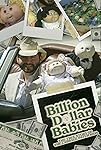Eye For Film >> Movies >> Billion Dollar Babies: The True Story Of The Cabbage Patch Kids (2022) Film Review
Billion Dollar Babies: The True Story Of The Cabbage Patch Kids
Reviewed by: Jennie Kermode

“What do we tell our little girl Christmas morning?” asks a distraught mother caught on camera on Black Friday, 1983. “What are we supposed to say? ‘You’ve been good but Santa ran short?’”
If you lived through the Eighties – even, or perhaps especially, if you were a child at the time – you will remember the Cabbage Patch Doll craze. Some people thought they were adorable, some people thought they were hideous, but nobody could ignore them. Packaged with adoption certificates, already given names, they were, we were assured, all unique individuals, no two alike, and collectors’ testimony tends to bear that out. Andrew Jenks’ documentary is much more than an exercise in nostalgia, however, as it attempts to get to the bottom of disputes over the origin of the dolls and understand the psychology that made them such a hit.
We begin with Little People dolls, all fabric, very huggable, with expressive rather than conventionally attractive faces, launched in 1077 by Xavier Roberts in rural Georgia. By chance, marketing man Roger Schlaifer bought one for his daughter Jessica. He thought the doll was ugly but the kid adored her, Lavinia Merle, and he realised that here was something with real potential. Soon he and Roberts were talking, and this led to the creation of Babyland, a ‘hospital’ where new dolls could be extracted from cabbages and damaged ones could be treated. Children adopted them, made a promise to be good parents, and adoption fees were paid.
It was a blessed moment, at the confluence of events which lifted it much higher than it could have flown on its own. New computer technology meant that it was suddenly possible to create products with unique variations for the mass market. Ronald Reagan became president; the US economy boomed; suddenly practically everyone had a credit card and there were few stories circulating to prompt caution about how they used it. Jenks captures the spirit of this in the style of the films of the time, with a montage: swatches, Wheel Of Fortune, excess everywhere. Advertising on children’s TV was deregulated so suddenly Schlaifer and Roberts could market directly to their targets, using them, in turn, to pressure adults. What’s more, the media was fascinated by all this, which meant lots of free coverage as well – regarding which journalist Connie Cheung says she still feels ashamed.
Perhaps the ugliness was part of it. We hear the dolls variously described as “ugly,” “pathetic looking,” “cute but funny looking.” “I don’t like their faces but I want one,” says one customer. To another, they are “bundles of polyester joy.” Their looks make them vulnerable, it is suggested. They need to be protected. Whatever happened, Coleco simply didn’t have the capacity to meet demand, and when actual scarcity increased their appeal, the consequence was a cornerstone of modern capitalism: mass adoption of artificial scarcity as a marketing technique. Archive footage and first person accounts remind us of the stampedes and injuries. We see a manager waving a baseball bat, another desperately throwing dolls to the mob, an ambulance arriving outside a store as four people are hospitalised. It quickly becomes apparent that this is more than just the story of the dolls. It is the story of the modern age.
“My name is Xavier Roberts and you probably don’t know me but I could be the father of one of your kids,” says the man himself, grinning, in his cowboy hat.
Then Jenks pulls the rug from under viewers and calls into question key aspects of what has gone before. The final third of the film presents us with an entirely new story, also with significant wider consequences. At every stage of the film, we get glimpses of the additional cultural narratives which spin off from this one. There’s a lot of ugly business in this documentary, but it is, without doubt, something unique.
Reviewed on: 23 Nov 2023
















